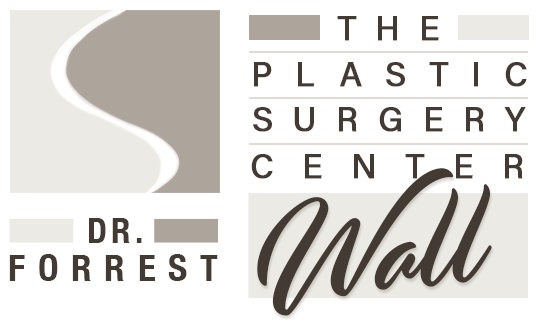BREAST REDUCTION SURGERY
Procedures
Breast Reduction in Shreveport and Monroe, LA
A breast reduction, also known as reduction mammaplasty for women and gynecomastia surgery for men, involves removing extra fat, tissue, and skin from the breasts. Breast reduction surgery may be used to relieve discomfort or attain a breast size that is proportional to your body if you have overly large breasts. For many people, breast reduction surgery also helps them to feel better about themselves and enhance their capacity to engage in physical activities.
If you’re considering breast reduction surgery in Shreveport, Monroe, or the surrounding areas, consult with renowned board-certified plastic surgeon Dr. Forrest Wall at The Plastic Surgery Center. He will be able to give you further information regarding your breast reduction surgery, as well as the potential risks and complications and what you can expect, all while carefully considering your individual factors. Call 318-221-1629 to get started today.
What are the Reasons for Breast Reduction?
Breast reduction surgery essentially allows for the breast to be pulled tighter with the removal of fatty tissue, glandular tissue, and excess skin. This creates a lighter and firmer appearance and feel.
Breast reduction can actually be a very helpful surgery for women who have large, potentially sagging breasts. There are actually several medical reasons for breast reduction surgery to occur. In fact, most people receive reduction mammaplasty, not for cosmetic purposes, but due to the medical problems overly large breasts often bring. Many times, these issues can create neck, back, and shoulder pain for women. Through reduction, they can better enjoy their lives and find relief from pain and low self-esteem due to breast size.
Do I Need a Breast Reduction?
Wondering if you are a candidate for breast reduction? Here are some reasons you might need reduction mammaplasty surgery:
- Excessive pain in your neck or back due to large breasts
- Breasts that are disproportionate to your body size
- Difficulty with exercising or other physical activities due to breast size
- Difficulty fitting into bras or clothing
- Asymmetry in breasts, with one being much larger
- Chronic irritation or skin rashes under the breasts
- Problems with self-image due to large breast size
If you experience one or more of these symptoms, you might benefit from a breast reduction. However, if you smoke, are obese, have a heart condition or diabetes, or do not want scars on your breasts, this surgery may not be recommended for you.
How is a Breast Reduction Done?
There is no one specific way for breast reduction surgery to be performed. Every patient is different and the technique used must be fit to their specific circumstances. For example, your surgeon may either conduct a minimally invasive surgery or an open surgery based on things like your age, medical history, general health, and breast size or shape.
You may also either be put under general anesthesia or regional anesthesia with intravenous sedation. Once you are properly sedated, your surgeon will make the incision into your breasts. There are a few different types of incisions that can be made, and your surgeon will choose the one best suited for you. Once the incision is made, the nipple is then repositioned and, if necessary, the perimeter surrounding the areola is reduced. Breast tissue is then removed and the breast is lifted and shaped.
Once the desired shape and size are achieved, your surgeon will make sutures deep within the underlying tissue for support. Then, sutures, surgical tape, or skin adhesive will be applied to close up the incisions.
What is Breast Reduction Surgery Recovery Like?
Your surgeon will immediately apply dressings or bandages to the incisions sites after your breast reduction surgery is complete. To reduce swelling and support the breasts while they recover, an elastic bandage or support bra will also be necessary.
A tiny, thin tube may be inserted beneath the breast skin to drain any extra blood or fluid that has accumulated. This is only used temporarily following surgery. You will also likely receive medications to reduce pain, aid in the healing process, and reduce the risk of infection.
Dr. Wall will provide you with everything you need to know about your recovery, including detailed aftercare instructions. It is critical that you follow these post-operative instructions. By doing so, you will likely be healed and able to engage in regular activities in just two to three weeks!
We provide additional information here: When to Sleep on Side After Breast Augmentation
Breast Reduction Risks
Breast reduction surgery carries the same risks and potential complications as any other major surgery. These risks may include:
- Bleeding
- Temporary bruising
- Infection
- Scarring
- Negative response to anesthesia
Potential risks that are relatively unique to surgical breast procedures include:
- Nipples and skin surrounding the nipples losing feeling
- Breast-feeding difficulties or incapacity
- Differences in the size, shape, and symmetry of breasts
How Old Do You Have to Be to Get a Breast Reduction?
Breast reduction surgery can virtually be done at any age if necessary, including as a teenager. While patients of all ages may undergo breast reduction, it is recommended that you wait until your breasts have fully developed. However, if you do choose to undergo surgery before your breasts have fully developed, you may require a second procedure later in life.
How Much Does a Breast Reduction Cost?
Breast reduction surgery costs vary based on a number of factors. As with many other products and services, the region in which you live may have a significant impact on the pricing. The cost of surgery also varies from one surgeon to the next. The price of a surgeon is typically determined by their years of experience, advanced training, and technique competence.
With all that being said, in the United States, the average cost of a breast reduction in and of itself is currently around $5,800. Remember, though, this is just an average and simply covers the cost of the actual procedure. Other expenses to consider may include:
- Fee for anesthesia
- Charges from hospital or surgical center
- Medical tests conducted prior to surgery
- Medication
- Undergarments required for proper recovery
However, unlike with other cosmetic breast procedures, breast reduction surgery may be covered by insurance. In order for insurance to cover the surgery, you need to prove that your large breast size causes you adverse health problems. Of course, whether or not your insurer will pay for it also largely depends on your specific policy. Call your insurance provider to find out if reduction mammaplasty is covered under your insurance plan or read our blog: Is Breast Reduction Surgery Covered by Health Insurance? to find out more.
Call Dr. Forrest Wall at the Plastic Surgery Center Today!
If you’re considering breast reduction surgery, schedule an appointment with Board Certified Plastic Surgeon Dr. Forrest Wall today to see if it’s right for you. Call the Plastic Surgery Center in Shreveport at 318-221-1629 or Monroe at 318-812-0182!

